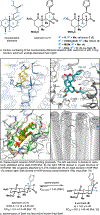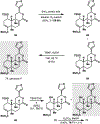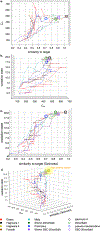Chemical syntheses of the salvinorin chemotype of KOR agonist
- PMID: 32808003
- PMCID: PMC7677207
- DOI: 10.1039/d0np00028k
Chemical syntheses of the salvinorin chemotype of KOR agonist
Abstract
Covering: 2000 to 2020 The hallucinogenic diterpene salvinorin A potently and selectively agonizes the human kappa-opioid receptor (KOR). Its unique attributes-lack of a basic nitrogen, rapid brain penetrance, short half-life-combined with the potential of KOR as an emerging target for analgesics have stimulated extensive medicinal chemistry based on semi-synthesis from extracts of Salvia divinorum. Total synthesis efforts have delivered multiple, orthogonal routes to salvinorin A, its congeners and related analogs with the goal of optimizing its activity towards multiple functional endpoints. Here we review total syntheses of the salvinorin chemotype and discuss outstanding problems that synthesis can address in the future.
Figures














Similar articles
-
A review of salvinorin analogs and their kappa-opioid receptor activity.Bioorg Med Chem Lett. 2018 May 15;28(9):1436-1445. doi: 10.1016/j.bmcl.2018.03.029. Epub 2018 Mar 12. Bioorg Med Chem Lett. 2018. PMID: 29615341 Free PMC article. Review.
-
A unique natural selective kappa-opioid receptor agonist, salvinorin A, and its roles in human therapeutics.Phytochemistry. 2017 May;137:9-14. doi: 10.1016/j.phytochem.2017.02.001. Epub 2017 Feb 10. Phytochemistry. 2017. PMID: 28190678
-
Salvinorin A, an active component of the hallucinogenic sage salvia divinorum is a highly efficacious kappa-opioid receptor agonist: structural and functional considerations.J Pharmacol Exp Ther. 2004 Mar;308(3):1197-203. doi: 10.1124/jpet.103.059394. Epub 2004 Jan 8. J Pharmacol Exp Ther. 2004. PMID: 14718611
-
Kappa-opioid receptor-selective dicarboxylic ester-derived salvinorin A ligands.Bioorg Med Chem Lett. 2013 May 15;23(10):2860-2. doi: 10.1016/j.bmcl.2013.03.111. Epub 2013 Apr 4. Bioorg Med Chem Lett. 2013. PMID: 23587424 Free PMC article.
-
From local to global-fifty years of research on Salvia divinorum.J Ethnopharmacol. 2014 Feb 3;151(2):768-83. doi: 10.1016/j.jep.2013.11.032. Epub 2013 Dec 4. J Ethnopharmacol. 2014. PMID: 24315983 Review.
Cited by
-
Salvinorin A and Salvia divinorum: Toxicology, Pharmacological Profile, and Therapeutic Potential.Int J Mol Sci. 2025 Jun 11;26(12):5588. doi: 10.3390/ijms26125588. Int J Mol Sci. 2025. PMID: 40565052 Free PMC article. Review.
-
Salvaging Salvinorin: From Hallucinogen to Potential Therapeutic through Chemical Synthesis.ACS Cent Sci. 2023 Aug 10;9(8):1522-1524. doi: 10.1021/acscentsci.3c00955. eCollection 2023 Aug 23. ACS Cent Sci. 2023. PMID: 37637730 Free PMC article. No abstract available.
-
A Protecting-Group-Free Synthesis of (-)-Salvinorin A.Chemistry. 2021 May 20;27(29):7968-7973. doi: 10.1002/chem.202100560. Epub 2021 May 2. Chemistry. 2021. PMID: 33784436 Free PMC article.
-
Asymmetric Syntheses of (+)- and (-)-Collybolide Enable Reevaluation of kappa-Opioid Receptor Agonism.ACS Cent Sci. 2022 Jul 27;8(7):948-954. doi: 10.1021/acscentsci.2c00442. Epub 2022 Jul 18. ACS Cent Sci. 2022. PMID: 35912357 Free PMC article.
-
Formal Total Synthesis of Salvinorin A.ChemistryOpen. 2022 Oct;11(10):e202200015. doi: 10.1002/open.202200015. Epub 2022 Feb 26. ChemistryOpen. 2022. PMID: 35218166 Free PMC article.
References
-
- Center for Behavioral Health Statistics and Quality (CBHSQ). 2017 National Survey on Drug Use and Health: Detailed Tables Rockville, MD: Substance Abuse and Mental Health Services Administration; 2018
-
- CDC/NCHS, National Vital Statistics System, Mortality. CDC WONDER, Atlanta, GA: US Department of Health and Human Services, CDC; 2018. https://wonder.cdc.gov
Publication types
MeSH terms
Substances
Grants and funding
LinkOut - more resources
Full Text Sources
Other Literature Sources

